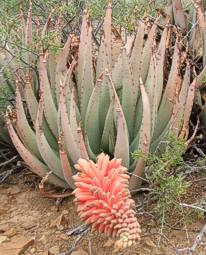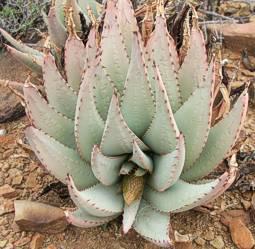Aloe claviflora
Aloe claviflora Burch.
Family: Asphodelaceae
Common names: kraal aloe, cannon aloe (Eng.); aanteelaalwyn, kanonaalwyn, kraalaalwyn (Afr.)
Introduction
Aloe claviflora is one of the easiest succulent plants to identify in the arid regions of the wild either by its angled inflorescence that protrudes horizontally from the side of the plant or by the circular arrangement in which the plants grow, resembling a camp fire.

Description
Description
Aloe claviflora grows in dense groups, most often in circular or half-circular patches of ten or more heads. Plants are normally stemless but in old specimens, short stems may form which grow horizontally along the ground. Unlike other typical aloes in arid areas, Aloe claviflora does not have erect rosettes. Instead they face outward, giving them a characteristically asymmetric shape. The firm, leathery textured leaves are greyish green, sometimes with a whitish appearance, up to 200 mm long, and have sharp brown spines along the margins. There are also some spines along the middle of the lower surface of the leaf which extend toward the leaf apex. The plants start as a small, dense, circular group which gradually continues to grow outwardly. This later causes a hollow to form in the middle of the circle as the plants continue to grow outward. This is a very typical feature of A. claviflora in the wild.
Another typical feature is the angle at which the inflorescence is produced. It is never erect but always at a slanted angle almost prostrate on the ground. One or two inflorescences may appear at a time which is from August and September. The inflorescences are usually unbranched but in rare cases up to four branches may appear. The racemes are oblong, densely flowered and up to 300 mm long. Each flower is distinctly club-shaped with the widest part near the mouth and the tube strongly tapering and gradually merging with the flower stalk. The buds and young flowers are bright red, but turn a yellow and whitish colour as they age with time. This gives a very attractive bicoloured appearance to the racemes. As with other members of the Asphodelaceae, the fruit is a typical capsule and seeds are small and winged, ripening normally around January.

Conservation Status
Status
Aloe claviflora is widely distributed in the dry interior of South Africa. The species is very common and not threatened.
Distribution and habitat
Distribution description
Aloe claviflora is found in the extremely arid areas of South Africa's interior in habitats ranging from flat stony ground, well-drained sandy expanses and raised rocky outcrops and hills. The natural distribution range extends from Vanrhynsdorp in the south to the Gariep River in the north and to the interior as far as Upington, Kakamas and Pella. Populations are normally found to be healthy and may occur in quite dense stands especially in the south where they blend in well with the Namaqualand scrubland.
Derivation of name and historical aspects
History
The genus name Aloe is derived from the Arabic, alloch, and translated as allal in Greek and Hebrew, literally meaning bitter or bitter sap which is descriptive of aloe sap. The specific epithet claviflora means club-shaped, referring to the flowers and is aptly chosen.
Aloe claviflora was first recorded in Burchell's Travels in the interior of southern Africa in 1811, where the plants were found growing near Fraserburg in the Northern Cape. The identity of Burchell's A. claviflora remained in doubt for well over 100 years, since the description was meagre and no figure had been published. However, due to some of Burchell's unpublished drawings of the plant dated 25 August 1811, little doubt was left that it was in fact A. claviflora which Dr Selmar Schonland, curator of the Albany Museum in Grahamstown subsequently described as A. schlechteri in 1903. Today Burchell's original A. claviflora is accepted with A. schlechteri and A. decora as synonyms.
The common names kraalaalwyn and kanonaalwyn are Afrikaans and very descriptive. Firstly, it describes the round circular shape that the plants form which resembles a round cattle enclosure or kraal. Secondly, kanonaalwyn, translated as canon aloe, refers to the shape and location of the inflorescence on the plant that resembles the shape of aiming canons.
Ecology
Ecology
Aloe claviflora produces nectar and is therefore pollinated by sunbirds as well as winged and crawling insects such as ants which are small enough to enter the flower tube in which the nectar is stored. After fertilization, the capsular fruits grow quickly and split into three parts in summer to release the wind-dispersed seeds. The plant in itself is very tough and can survive often for several seasons without water, at which point the leaves turn a whitish colour to help reflect the sun away from the plant. The leaves also close inwardly to form tough round balls that effectively protect the young leaves from heat stress. It is not known to be eaten by many animals besides occasionally rock hyrax, porcupine, and hare.
Uses
Use
No medicinal uses are recorded for Aloe claviflora. There is no doubt that it would make a very attractive plant for arid gardens and containers and since it is so well adapted to tough arid conditions, will do well in the dryer parts of the country.

Growing Aloe claviflora
Grow
Aloe claviflora grows relatively easily in cultivation if not overwatered and is grown in full sun. It can easily be transplanted and grows well in containers. Success may be achieved by sowing fresh seeds which are potted several times.
Artificially, a smallish rock garden that provides some shelter for A. claviflora, provides the best growing conditions but only in low rainfall areas.
Companion plants to Aloe claviflora include A. aristata, A. bowiea, A. brevifolia, A. humilis, A. krapohliana, A. microstigma, A. falcata, A. dinteri, A. melanacantha and A. sladeniana. Other companion plants to consider are Lampranthus aureus, L. multiradiatus, L. reptans, Pelargonium echinatum, P. xerophytum, P. spinosum, P. sericifolia, P. crithmifolium, Stoeberia arborescens, Gazania krebsiana, Hermannia saccifera and Oscularia deltoides.
References
- Court, D. 1981. Succulent flora of southern Africa. Balkema, Cape Town.
- Germishuizen, G. & Meyer, N.L. (eds). 2003. Plants of southern Africa : an annotated checklist. Strelitzia 14. National Botanical Institute, Pretoria.
- Jackson, W.P.U. 1990. Origins and meanings of South African plant genera. University of Cape Town Ecolab.
- Leistner, O.A. 2005. Seed plants of southern and tropical Africa : families and genera. Southern African Botanical Diversity Network Report No. 26. SABONET, Pretoria.
- Reynolds, G.W. 1950. The aloes of South Africa. Johannesburg
- Rothmann, S. 2004. Aloe aristocrats of Namibian flora. Creda Press, Cape Town.
- Smith, C.A. 1966. Common names of South African plants. Memoirs of the Botanical Survey of South Africa No. 35.
- Smith, G.F. & Van Wyk, B-E. 2008. Aloes in southern Africa. Struik, Cape Town.
- Stearn, W.T. 2003. Stearn's dictionary of plant names for the gardener. Cassel, UK.
- Van Wyk, B-E. & Smith, G. 1996. Guide to aloes of South Africa. Briza Publications, Pretoria.
Credits
Werner Voigt
Harold Porter National Botanical Garden
October 2009
Plant Attributes:
Plant Type: Shrub, Succulent
SA Distribution: Eastern Cape, Free State, North West, Northern Cape, Western Cape
Soil type: Sandy
Flowering season: Spring
PH:
Flower colour: Red, Yellow
Aspect: Full Sun
Gardening skill: Average
Special Features:
Horticultural zones








Rate this article
Article well written and informative
Rate this plant
Is this an interesting plant?
Login to add your Comment
Back to topNot registered yet? Click here to register.